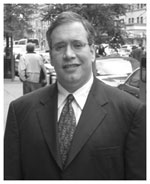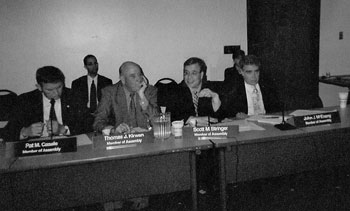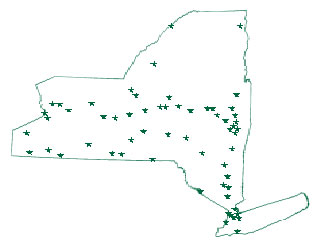Energy Cost Savings Program
The Committee passed a bill to extend the Energy Cost Savings Program (ECSP) and the Lower Manhattan
Energy Program (LMEP), which provide utility rebates for certain New York City businesses. It is
essential that the State encourage the growth of new and existing businesses throughout New York
City so that our economy can continue to rebuild and expand.
RePAIR Program
The Revitalization Projects and Infrastructure Renewal (RePAIR) Program, Assembly bill
A.4579 sponsored by Assemblymember Sam Hoyt, provides financial
support to assist cities with the demolition and disposal of abandoned buildings and vacated
warehouses. If enacted, this program would provide roughly $5 million in local aid to cities for
demolition of these vacant structures, thereby freeing up space for city leaders to develop
properties attractive for business and other economic development initiatives. This bill passed the
Assembly Committee on Cities and currently awaits action in the Assembly Ways & Means Committee.
"Total Collapse":
Reforming NYC Department of Buildings
In November 2002, Committee Chair Scott Stringer’s office released a scathing report, "Total
Collapse: How NYC Department of Buildings Failed Policies Contribute to Crumbling Buildings,"
exposing the dangerous conditions in New York City buildings and the failure of the Department of
Buildings (DOB) to address these violations. Assemblymember Stringer introduced legislation
(A.8117) to respond to weaknesses within the DOB and take thousands of
New Yorkers’ lives out of danger. New York City can substantially reduce outstanding building
violations by mandating that building inspectors record all violations present in a building and
report the violations to the relevant agency if needed. It is imperative to increase tenant
awareness of needed repairs in their buildings through public notice detailing outstanding
violations.
Overall, Assembly bill A.8117 strengthens the enforcement arm of the DOB and its ability to protect
the residents of New York City’s buildings.
New York City Charter Revision Reform
The City Charter governs all New York City residents, but only a select few are allowed to sit on
City Charter Revision Commissions to create proposals to amend the charter. The Committee believes
these Commissions should be representative of all New York City residents, which is why the
Committee pushed A.8828, which would require the Mayor to appoint a Commission based upon
nominations by the Comptroller, the Public Advocate, and the Borough Presidents acting together. In
addition, one member would be nominated by each of the borough delegations of the City Council.
Not only would this legislation make Charter Revision Commissions more representative, it would also
ensure that the Commission is appointed by February 15th, thus providing adequate time for proposals
to be considered before being placed on the ballot. The recent passage of this bill in the Assembly
sends a loud message to all city governments: Do not abuse the process of governing.
Empire Zone Program Reform
When first proposed by the Assembly, the Empire Zone Program represented an innovative economic
development tool to provide tax incentives for businesses within specified urban areas to create
jobs. Unfortunately, the implementation and management of this program has been woefully inadequate.
Many eligible businesses have been denied benefits under the program, while businesses not
qualifying for the program have inexplicably received Empire Zone benefits.
Given the critical role of New York’s businesses in rebuilding our cities, it is past time that we
reform a plan exhibiting such potential to boost New York’s economy. Passage of the Assembly’s
Empire Zone reform package would restore the integrity of this program and return the Empire Zone
Program to its original intent of job creation in New York State.
|



